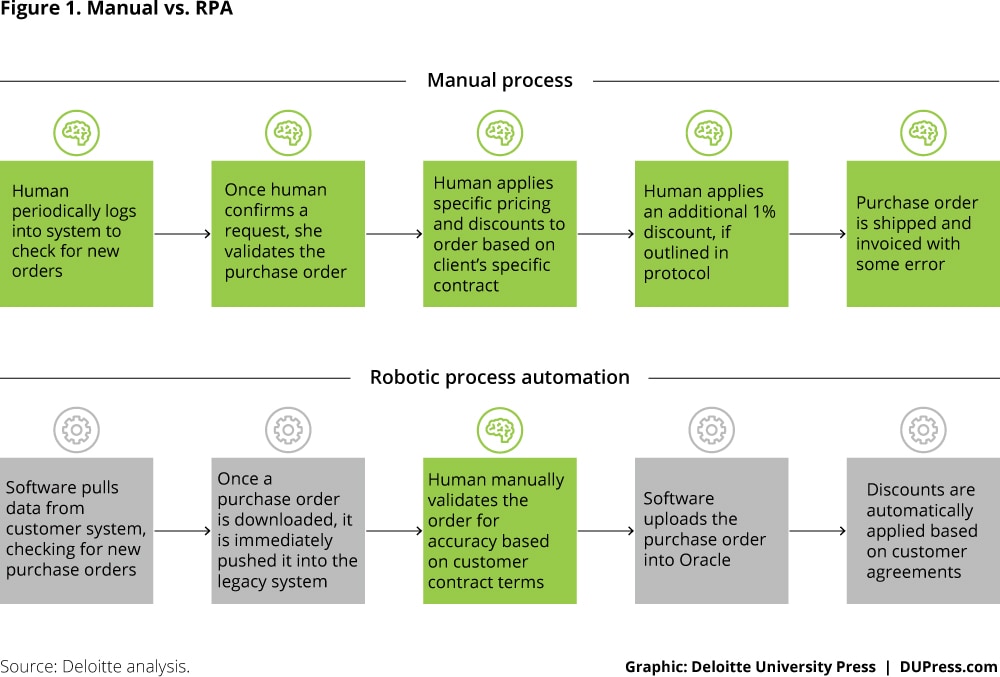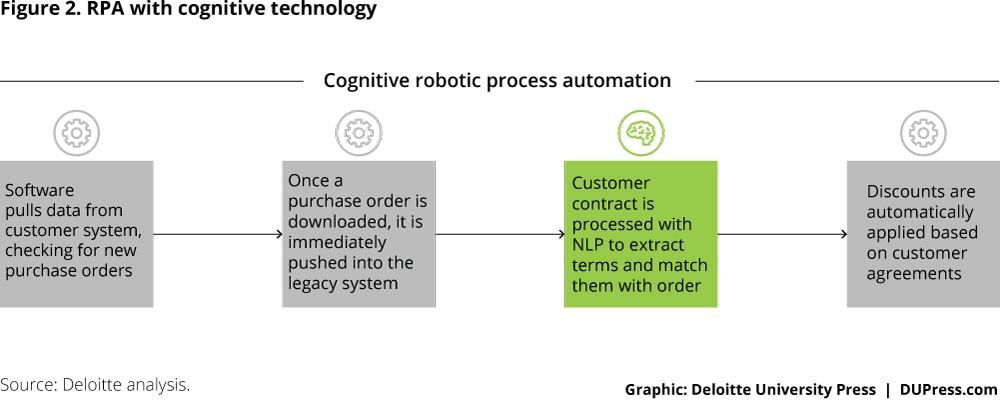Robotic process automation has been saved

Robotic process automation A path to the cognitive enterprise
14 September 2016
Bots can automate routine tasks and eliminate inefficiency, but what about higher-order work requiring judgment and perception? Developers are incorporating cognitive technologies, including machine learning and speech recognition, into robotic process automation—and giving bots new power.
Companies are increasingly using software robots to perform routine business processes by mimicking the ways in which people interact with software applications. And the rapidly growing market for robot process automation (RPA) is already showing signs of an important emerging trend: Enterprises are beginning to employ RPA together with cognitive technologies such as speech recognition, natural language processing, and machine learning to automate perceptual and judgment-based tasks once reserved for humans. The integration of cognitive technologies and RPA is extending automation to new areas and can help companies become more efficient and agile as they move down the path of becoming fully digital businesses.
Signals
- Leading RPA vendors are incorporating cognitive technologies such as natural language processing, machine learning into their offerings1
- Large RPA providers are partnering with vendors of cognitive technologies; for example, Blue Prism and IBM Watson have partnered to bring cognitive capabilities to clients2
- Enterprises across industries such as banking, insurance, and transportation have deployed RPA with cognitive technologies to automate routine business processes such as fulfilling purchase orders and new hire onboarding3
- Analyst firm Forrester suggests that a best practice for installing RPA is to “design the system to potentially link with cognitive platforms.”4
A quest for cost savings, scale, and speed
RPA software automates repetitive, rules-based processes usually performed by people sitting in front of computers. By interacting with applications just as a human would, software robots can open email attachments, complete e-forms, record and re-key data, and perform other tasks that mimic human action. Robots can be seen as a virtual workforce assigned to middle- and back-office processing centers. There are also applications for which software assists front-office staff—for instance, prompting contact center agents during customer interactions and automatically capturing call close notes, a mode known as “attended automation.”5
The emerging trend we are highlighting here is the growing use of cognitive technologies in conjunction with RPA. But before describing that trend, let’s take a closer look at these software robots, or bots.
RPA’s potential benefits are manifold. They can include reducing costs (by cutting staff), lowering error rates, improving service, reducing turnaround time, increasing the scalability of operations, and improving compliance. For instance, a large consumer and commercial bank redesigned its claims process and deployed 85 software robots, or bots, running 13 processes, handling 1.5 million requests per year. As a result, the bank was able to add capacity equivalent to around 230 full-time employees at approximately 30 percent of the cost of recruiting more staff. Additionally, the bank recorded a 27 percent increase in tasks performed “right first time.”6
Beyond automating existing processes, companies are using bots to implement new processes that would otherwise be impractical. For instance, UK retailer group Shop Direct used RPA to identify flood-affected customers and automatically remove late payment charges from their accounts.7 Financial services providers have also used such “one-off” RPA implementations to comply with regulatory requirements in areas such as remediation processing, monitoring, and reporting.
Figure 1 depicts a typical back-office process before and after implementing RPA.8
RPA tools interact with existing legacy systems at the presentation layer, with each bot assigned a login ID and password enabling it to work alongside human operations employees. Business analysts can work with business operations specialists to “train” and to configure the software. Because of its non-invasive nature, the software can be deployed without programming or disruption of the core technology platform.
A proof-of-concept RPA project may take as little as two weeks; a pilot could be up and running within four to eight weeks, depending on scope and complexity.9 But the real effort of installing and integrating bots varies according to a company’s specific circumstances. Where little data is available in digital form, or where processes are dominated by special cases and exceptions, the effort could be greater. Some RPA efforts quickly lead to the realization that automating existing processes is undesirable and that designing better processes is warranted before automating those processes.
It is worth noting that RPA’s ability to wring substantial process improvements from legacy systems, often at relatively low cost, can undermine the business case for large-scale replacement of systems or enterprise application integration initiatives.
While the RPA market today is still small, the technology is gaining traction as a cost-effective alternative to traditional systems integration and is projected to become a $5 billion market globally by 2020, with a CAGR of over 60 percent.10 According to one analysis, as many as a third of global enterprises are actively using bots within their IT and finance and accounting processes, with about a quarter adopting RPA within procurement and HR processes.11 Some enterprises are deploying this software at scale, automating dozens of processes with hundreds of bots, setting up robotic centers of excellence, and appointing a senior executive as “head of robotic automation.”
Cognitive technologies extending RPA’s reach
Bots can perform only tasks with clear-cut rules. This means that processes that require human judgment within complex scenarios—for example, complex claims processing—cannot be automated through RPA alone. One RPA vendor reports that even its most mature clients automate at most 50 percent of back-office processes, and the majority of clients automate far fewer.12 This is why some enterprises consider RPA to be part of an “integrated workforce” in which bots work alongside people, taking on relatively simple activities so that people can focus on those complex exceptions. But the line between what humans and computers can do is shifting.
The integration of cognitive technologies with RPA makes it possible to extend automation to processes that require perception or judgment. With the addition of natural language processing, chat-bot technology, speech recognition, and computer vision technology, for instance, bots can extract and structure information from speech audio, text, or images and pass that structured information to the next step of the process. Another example: Machine learning can identify patterns and make predictions about process outcomes, helping RPA prioritize actions.
Cognitive RPA has the potential to go beyond basic automation to deliver business outcomes such as greater customer satisfaction, lower churn, and increased revenues.
Figure 2 illustrates how RPA and a cognitive tool might work in tandem to produce end-to-end automation of the process shown in figure 1 above.
Illustrating the benefits of cognitive RPA, a leading global bank used cognitive RPA to automate 57 percent of its payments work in the highly regulated area of foreign trade finance. Challenges of automating this process end-to-end included the need to work with: highly unstructured data such as invoices, bills, declarations, certificates, and letters; a high daily volume of transactions requiring same-day processing; complex business processes; and the need to interface with multiple core systems. The solution combined traditional RPA techniques with a host of cognitive technologies to automate most steps in the process, reducing the number of full-time staff required to perform the process from 110 to 47.13
Other examples of cognitive RPA are appearing in a number of industries:
- Virgin Trains has deployed cognitive RPA to automatically refund customers for late running trains. As customer emails arrive, a natural language processing tool reads, understands meaning and sentiment, categorizes, and then recognizes key information in the text to service the customer quickly and cleanly.14 From discerning the customer’s complaint with cognitive computing to actively issuing the refund with software bots, the entire process has been automated. The cognitive automation solution has reduced daily processing time and manual labor involved in dealing with customer emails by 85 percent.15
- A US bank turned to cognitive RPA to automate its billing system and thereby eliminate revenue leakage due to mismatches between rate cards and client invoices. Among a number of challenges for traditional bots, client invoices and contracts were in paper form or PDFs and in multiple languages, and reconciliation between paper documents was manual-intensive and prone to error. The bank utilized natural language processing techniques to scan fee schedules and invoices and translated process requirements into an automated, executable business process workflow, identifying billing opportunities and breaks. As a result, managers uncovered revenue leakage of 9–10 percent; they recovered 3–4 percent.16
- A global information services firm has deployed a cognitive automation platform to automatically handle its 7 million annual faxes from clients. The platform’s OCR process structures data by converting the document images into machine-readable text. Subsequently, the system uses user-defined rules and machine learning capabilities to extract the data and categorize the faxes accordingly.17
RPA vendors embracing cognitive
To extend the field of application of RPA tools, leading vendors are investing in cognitive technologies such as machine learning, speech recognition, and natural language processing.18 For example, RPA developer Automation Anywhere has developed computer vision technologies and machine learning capabilities in-house. In loan processing, the company has used natural language processing techniques to extract sentiment from supporting documentation in order to establish loan applicants’ creditworthiness.19 UiPath says it is working with cognitive technology tools from third parties, including open-source machine learning libraries,20 to craft point solutions for clients.21 Blue Prism’s cognitive strategy centers on partnering with cognitive technology specialists. The company has announced a partnership with IBM Watson, with the goal of integrating cognitive technologies into process flows.22
While many large enterprise software vendors have begun to incorporate cognitive technologies into their products,23 and applications of machine learning that provide greater insight to organizations are proliferating, we believe that enterprises have been relatively slow to implement cognitive process automation applications.24 This is because architecting and building custom solutions based on cognitive technologies can be complex, and the required skills scarce. The growing RPA market is likely to increase the pace at which cognitive automation takes hold, as enterprises expand their robotics activity from RPA to complementary cognitive technologies.
Deploying cognitive tools via bots can be faster, easier, and cheaper than building dedicated platforms. By “plugging” cognitive tools into RPA, enterprises can leverage cognitive technologies without IT infrastructure investments or large-scale process re-engineering. Therefore, businesses that have deployed RPA may be more likely to find valuable applications for cognitive technologies than those that have not.
Implications
The potential benefits of deploying cognitive technologies through RPA frameworks include faster implementation with less effort and more rapid ROI than either in-house development or platform investments could deliver. Many considerations emerge:
Look beyond basic bots. When implementing RPA, consider potential for cognitive enhancements. Cognitive RPA can not only enhance back-office automation but extend the scope of automation possibilities.
Review talent models. Enterprises that deploy RPA tend to focus on opportunities to eliminate jobs. But they may also gain the capacity to scale their operations and more fluidly handle demand spikes. The use of cognitive RPA may present opportunities to redesign jobs and reassign people to higher-value roles, including customer-facing and problem-solving functions.25
Business process outsourcing providers face an opportunity and a threat. The stakes are high for BPO players. Given that a software robot can cost as little as one-third the price of an offshore FTE, RPA offers an alternative to some BPO relationships. Potentially, bots can automate as much as 40 percent of BPO human labor,26 with cognitive technologies taking that figure even higher. Companies that offer BPO services are responding to the threat of automation by building out cognitive RPA capabilities themselves or partnering with vendors.27
RPA on the path to the cognitive enterprise
Many organizations are just beginning to explore the use of robotic process automation. As they do so, they would benefit from taking a strategic perspective. Bots can do much more than automate routine process steps. RPA can be a pillar of efforts to digitize businesses and to tap into the power of cognitive technologies.
Deloitte provides Robotic and Cognitive Automation (RCA) services to help our clients address their strategic and critical operational challenges. We help clients in a number of ways, ranging from shaping automation strategies and identifying key opportunities to designing and implementing robotic and cognitive enabled business operations and processes at scale, as well as providing robust automated managed services. Our approach places business outcomes and successful workforce integration of these RCA technologies at the heart of what we do, driven heavily by our deep industry and functional knowledge. Our thought leadership and strong relationships with both established and emerging tool vendors enables us and our clients to stay at the leading edge of this new frontier.
Our global Deloitte firm has a large and growing capability, with a range of thought leaders. For more information within the United States, please contact Peter Lowes at plowes@deloitte.com. For more information within the UK and Europe, please contact John Middlemiss at jmiddlemiss@deloitte.co.uk.






